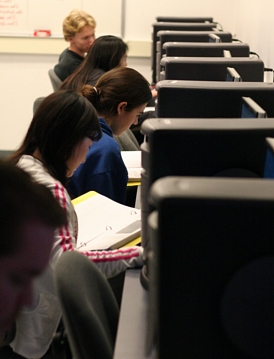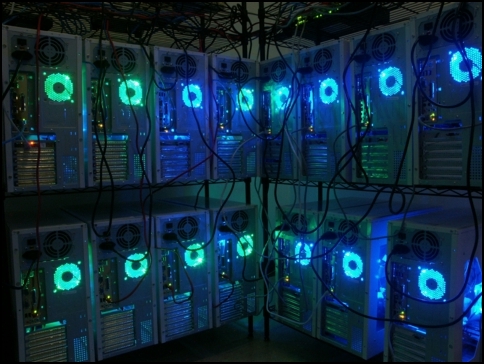![]()
"Machines have no judgement and will not remonstrate with us when our will is foolish."
Orson Scott Card, Children of the Mind, 1996
The primary tools of our research are those of theoretical organic and computational chemistry. Methods ranging from empirical to ab initio in nature are applied to problems in molecular structure and reactivity.
Click here for a nice collection of papers on modern applications in organic chemistry.
Quantum Mechanics
Hartree-Fock (HF) methods, post-Hartree-Fock (MPn, coupled cluster, CAS) methods, density functional theory (DFT), exteded Huckel theory, molecular mechanics and combinations thereof are applied to the following problems:
geometry optimization of stable molecules, reactive intermediates, and transition state structures
prediction of activation barriers and energies of reaction
characterization of transition states (using frequency and intrinsic reaction coordinate (IRC) calculations)
conformational analysis of small molecules
geometries and energetics of organometallic systems (using effective core potential, all-electron, and ONIOM methods)
solvent effects (using continuum SCRF and explicit solvation models)
characterization of multicenter bonding
prediction of 1H, 13C, 31P and 15N NMR chemical shifts
prediction of proton affinities, ionization energies, and electron affinities
prediction of kinetic and equilibrium isotope effects
"quantification" of aromaticity (using nucleus-independent chemical shift (NICS) calculations)
quantification of supramolecular stabilization (using theozymes)
prediction of kinetic and equilibrium isotope effects
simulation of dynamic behavior
Software: Gaussian, ADF, GAMESS, Spartan, Macromodel, YAeHMOP, ProgDyn, CREST

Docking, Protein Structure Prediction, and Bioinformatics
Automated docking and geometry optimization methods based on molecular mechanics, genetic algorithms and Monte Carlo simulated annealing techniques, as well as bioinformatic methodologies, are applied to the following problems:
prediction of binding modes for small organic molecules to proteins
characterization of binding modes for transition states to enzymes and catalytic antibodies
prediction of the three dimensional structure of proteins (using homology modeling and energy minimization by force fields)
computational mutagenesis
sequence as a predictor of catalytic function and inhibitor or hapten binding
rational drug design
virtual library screening
principal moment of inertia analysis for characterizing combinatorial library diversity
Programs: AutoDock, Insight II, AMBER, GRASP, Procheck, BLAST and ENTREZ at NCBI, GCG programs, Protein Data Bank (PDB)
Supercomputing Resources
Supercomputing resources for our research have been generously provided by XSEDE/PSC.

